Nutrient Solution Electrical Conductivity Affects Yield and Growth of Sub-Irrigated Tomatoes
Abstract
1. Introduction
2. Materials and Methods
2.1. Growing Conditions
2.2. Plant Material
2.3. Sub-Irrigation and Drip-Irrigation Set Up
2.4. Electrical Conductivity Treatments
2.5. Yield and Growth Parameters
2.6. Substrate pH and EC
2.7. Statistical Analysis
3. Results and Discussion
3.1. Plant Growth
3.2. Fruit Yield
3.3. Fruit Yield Evolution
3.4. Fruit Grades
3.5. Substrate Electrical Conductivity and pH
4. Conclusions
Author Contributions
Funding
Data Availability Statement
Acknowledgments
Conflicts of Interest
References
- Mojid, M.A.; Biswas, S.K.; Wyseure, G.C.L. Interaction Effects of Irrigation by Municipal Wastewater and Inorganic Fertilisers on Wheat Cultivation in Bangladesh. Field Crop. Res. 2012, 134, 200–207. [Google Scholar] [CrossRef]
- Arndt, C.; Diao, X.; Dorosh, P.; Pauw, K.; Thurlow, J. The Ukraine War and Rising Commodity Prices: Implications for Developing Countries. Glob. Food Secur. 2023, 36, 100680. [Google Scholar] [CrossRef] [PubMed]
- Massa, D.; Magán, J.J.; Montesano, F.F.; Tzortzakis, N. Minimizing Water and Nutrient Losses from Soilless Cropping in Southern Europe. Agric. Water Manag. 2020, 241, 106395. [Google Scholar] [CrossRef]
- Ferrarezi, R.S.; Weaver, G.M.; van Iersel, M.W.; Testezlaf, R. Subirrigation: Historical Overview, Challenges, and Future Prospects. HortTechnology 2015, 25, 262–276. [Google Scholar] [CrossRef]
- Mashhor, M.V.; Mashal, M.; Hashemi Garmdareh, S.E.; Reca, J.; Lao, M.T.; Veravipour, M.; Ebrahimian, H. Growth, Yield, and Water Productivity Responses of Pepper to Sub-Irrigated Planter Systems in a Greenhouse. Sustainability 2020, 12, 1100. [Google Scholar] [CrossRef]
- Wortman, S.E. Crop Physiological Response to Nutrient Solution Electrical Conductivity and pH in an Ebb-and-Flow Hydroponic System. Sci. Hortic. 2015, 194, 34–42. [Google Scholar] [CrossRef]
- Richa, A.; Touil, S.; Fizir, M.; Martinez, V. Recent Advances and Perspectives in the Treatment of Hydroponic Wastewater: A Review. Rev. Environ. Sci. Bio/Technol. 2020, 19, 945–966. [Google Scholar] [CrossRef]
- Macherla, K.; McAvoy, R.J. The Effect of Salinity on the Growth and Nutrient Status of Zinnia Grown Under Short- and Long-Cycle Subirrigation Management. HortScience 2017, 52, 770–773. [Google Scholar] [CrossRef]
- Chidiac, J. Shallow Aggregate Ebb-and-Flow System for Greenhouse Lettuce Production. Master’s Thesis, University of Arkansas, Fayetteville, AR, USA, 2017; 47p. [Google Scholar]
- Semananda, N.; Ward, J.; Myers, B. A Semi-Systematic Review of Capillary Irrigation: The Benefits, Limitations, and Opportunities. Horticulturae 2018, 4, 23. [Google Scholar] [CrossRef]
- Mukhopadhyay, R.; Sarkar, B.; Jat, H.S.; Sharma, P.C.; Bolan, N.S. Soil Salinity under Climate Change: Challenges for Sustainable Agriculture and Food Security. J. Environ. Manag. 2021, 280, 111736. [Google Scholar] [CrossRef]
- Lieth, J.H.; Oki, L.R. Chapter 9—Irrigation in Soilless Production. In Soilless Culture, 2nd ed.; Raviv, M., Lieth, J.H., Bar-Tal, A., Eds.; Elsevier: Boston, MA, USA, 2019; pp. 381–423. [Google Scholar] [CrossRef]
- Ullah, I.; Hanping, M.; Chuan, Z.; Javed, Q.; Azeem, A. Optimization of Irrigation and Nutrient Concentration Based on Economic Returns, Substrate Salt Accumulation and Water Use Efficiency for Tomato in Greenhouse. Arch. Agron. Soil Sci. 2017, 63, 1748–1762. [Google Scholar] [CrossRef]
- Venezia, A.; Colla, G.; Di Cesare, C.; Stipic, M.; Massa, D. The Effect of Different Fertigation Strategies on Salinity and Nutrient Dynamics of Cherry Tomato Grown in a Gutter Subirrigation System. Agric. Water Manag. 2022, 262, 107408. [Google Scholar] [CrossRef]
- Santamaria, P.; Campanile, G.; Parente, A.; Elia, A. Subirrigation vs Drip-Irrigation: Effects on Yield and Quality of Soilless Grown Cherry Tomato. J. Hortic. Sci. Biotechnol. 2003, 78, 290–296. [Google Scholar] [CrossRef]
- García-Santiago, J.C.; Valdez-Aguilar, L.A.; Cartmill, D.L.; Cartmill, A.D.; Juárez-López, P.; Alvarado-Camarillo, D. Subirrigation of Container-Grown Tomato I: Decreased Concentration of the Nutrient Solution Sustains Growth and Yield. Water 2019, 11, 2064. [Google Scholar] [CrossRef]
- Gillespie, D.P.; Papio, G.; Kubota, C. High Nutrient Concentrations of Hydroponic Solution Can Improve Growth and Nutrient Uptake of Spinach (Spinacia oleracea L.) Grown in Acidic Nutrient Solution. HortScience 2021, 56, 687–694. [Google Scholar] [CrossRef]
- Giuffrida, F.; Leonardi, C. Nutrient Solution Concentration on Pepper Grown in a Soilless Closed System: Yield, Fruit Quality, Water and Nutrient Efficiency. Acta Agric. Scand. Sect. B Soil Plant Sci. 2012, 62, 1–6. [Google Scholar] [CrossRef]
- El Youssfi, L.; Choukr-Allah, R.; Santamaria, P.; Montesano, F. Soilless Closed Cycle Production of Green Bean (Phaseolus vulgaris L.) Using Subirrigation: Effects on Yield, Fruit Quality, Substrate and Nutrient Solution Parameters. Acta Hortic. 2012, 938, 383–390. [Google Scholar] [CrossRef]
- Méndez-Cifuentes, A.; Valdez-Aguilar, L.A.; Cadena-Zapata, M.; González-Fuentes, J.A.; Hernández-Maruri, J.A.; Alvarado-Camarillo, D. Water and Fertilizer Use Efficiency in Subirrigated Containerized Tomato. Water 2020, 12, 1313. [Google Scholar] [CrossRef]
- Jani, A.D.; Meadows, T.D.; Eckman, M.A.; Ferrarezi, R.S. Automated Ebb-and-Flow Subirrigation Conserves Water and Enhances Citrus Liner Growth Compared to Capillary Mat and Overhead Irrigation Methods. Agric. Water Manag. 2021, 246, 106711. [Google Scholar] [CrossRef]
- Ramírez-Galicia, K.; López López, M.Á.; Cetina-Alcalá, V.M.; Mohedano Caballero, L. Prototipo de vivero forestal con fertirriego por subirrigación. Rev. Mex. Cienc. For. 2022, 13, 174–185. [Google Scholar] [CrossRef]
- Buwalda, F.; Baas, R.; Van Weel, P.A. A Soilless Ebb-and-Flow System for All-Year-Round Chrysanthemums. Acta Hortic. 1993, 361, 123–132. [Google Scholar] [CrossRef]
- United States Department of Agriculture. US Consumer Standards for Fresh Tomatoes; United States Department of Agriculture: Washington, DC, USA, 2018; 8p.
- de Mendiburu, F. Agricolae: Statistical Procedures for Agricultural Research. 2021. Available online: https://cran.r-project.org/web/packages/agricolae/index.html (accessed on 11 May 2023).
- Heinen, M.; Marcelis, L.F.M.; Elings, A.; Figueroa, R. Effects of EC and fertigation strategy on water and nutrient uptake of tomato plants. In Proceedings of the IV International Symposium on Models for Plant Growth and Control in Greenhouses: Modeling for the 21st Century—Agronomic and Greenhouse Crop Models, Beltsville, MD, USA, 25–29 March 2001; Volume 593, pp. 101–107. [Google Scholar]
- Rouphael, Y.; Colla, G. The Influence of Drip Irrigation or Subirrigation on Zucchini Squash Grown in Closed-Loop Substrate Culture with High and Low Nutrient Solution Concentrations. HortScience 2009, 44, 306–311. [Google Scholar] [CrossRef]
- Luna-Fletes, J.A.; Cruz-Crespo, E.; Can-Chulim, Á. Piedra Pómez, Tezontle y Soluciones Nutritivas en el Cultivo de Tomate Cherry. Rev. Terra Latinoam. 2021, 39, 1–12. [Google Scholar] [CrossRef]
- Rouphael, Y.; Colla, G. Growth, Yield, Fruit Quality and Nutrient Uptake of Hydroponically Cultivated Zucchini Squash as Affected by Irrigation Systems and Growing Seasons. Sci. Hortic. 2005, 105, 177–195. [Google Scholar] [CrossRef]
- Bouchaaba, Z.; Santamaria, P.; Choukr-Allah, R.; Lamaddalena, N.; Montesano, F.F. Open-Cycle Drip vs Closed-Cycle Subirrigation: Effects on Growth and Yield of Greenhouse Soilless Green Bean. Sci. Hortic. 2015, 182, 77–85. [Google Scholar] [CrossRef]
- Langenfeld, N.J.; Pinto, D.F.; Faust, J.E.; Heins, R.; Bugbee, B. Principles of Nutrient and Water Management for Indoor Agriculture. Sustainability 2022, 14, 10204. [Google Scholar] [CrossRef]
- Arif, Y.; Singh, P.; Siddiqui, H.; Bajguz, A.; Hayat, S. Salinity Induced Physiological and Biochemical Changes in Plants: An Omic Approach Towards Salt Stress Tolerance. Plant Physiol. Biochem. 2020, 156, 64–77. [Google Scholar] [CrossRef]
- Dorai, M.; Papadopoulos, A.; Gosselin, A. Influence of electric conductivity management on greenhouse tomato yield and fruit quality. Agronomie 2001, 21, 367–383. [Google Scholar] [CrossRef]
- Magán, J.J.; Gallardo, M.; Thompson, R.B.; Lorenzo, P. Effects of Salinity on Fruit Yield and Quality of Tomato Grown in Soil-less Culture in Greenhouses in Mediterranean Climatic Conditions. Agric. Water Manag. 2008, 95, 1041–1055. [Google Scholar] [CrossRef]
- Fayezizadeh, M.R.; Ansari, N.A.Z.; Albaji, M.; Khaleghi, E. Effects of Hydroponic Systems on Yield, Water Productivity and Stomatal Gas Exchange of Greenhouse Tomato Cultivars. Agric. Water Manag. 2021, 258, 107171. [Google Scholar] [CrossRef]
- Wang, K.; Ali, M.M.; Pan, K.; Su, S.; Xu, J.; Chen, F. Ebb-and-flow Subirrigation Improves Seedling Growth and Root Morphology of Tomato by Influencing Root-Softening Enzymes and Transcript Profiling of Related Genes. Agronomy 2022, 12, 494. [Google Scholar] [CrossRef]
- Bonaguro, J.E.; Coletto, L.; Sambo, P.; Nicoletto, C.; Zanin, G. Environmental Analysis of Sustainable Production Practices Applied to Cyclamen and Zonal Geranium. Horticulturae 2021, 7, 8. [Google Scholar] [CrossRef]
- Gent, M.P.N.; Elmer, W.H.; McAvoy, R.J. Water Use Efficiency with Rapid Watering of Potted Plants on Flooded Floors. In Proceedings of the XXVIII International Horticultural Congress on Science and Horticulture for People (IHC2010): International Symposium on Greenhouse 2010 and Soilless Cultivation, Lisbon, Portugal, 22 August 2010; Volume 927, pp. 101–107. [Google Scholar]
- Gent, M.P.; McAvoy, R.J. Water and Nutrient Uptake and Use Efficiency with Partial Saturation Ebb and Flow Watering. HortScience 2011, 46, 791–798. [Google Scholar] [CrossRef]
- Ji, Y.; Nuñez Ocaña, D.; Choe, D.; Larsen, D.H.; Marcelis, L.F.; Heuvelink, E. Far-red Radiation Stimulates Dry Mass Partitioning to Fruits by Increasing Fruit Sink Strength in tomato. New Phytol. 2020, 228, 1914–1925. [Google Scholar] [CrossRef] [PubMed]
- Matysiak, B.; Bielenin, M. Effect of Nutrient Solution Composition on Growth, Flowering, Nutrient Status and Cold Hardiness of Rhododendron yakushimanum Grown on Ebb-and-Flow Benches. Eur. J. Hortic. Sci. 2005, 70, 35–42. [Google Scholar]
- Zhang, P.; Senge, M.; Dai, Y. Effects of Salinity Stress at Different Growth Stages on Tomato Growth, Yield, and Water-Use Efficiency. Commun. Soil Sci. Plant Anal. 2017, 48, 624–634. [Google Scholar] [CrossRef]
- Tanveer, K.; Gilani, S.; Hussain, Z.; Ishaq, R.; Adeel, M.; Ilyas, N. Effect of Salt Stress on Tomato Plant and the Role of Calcium. J. Plant Nutr. 2020, 43, 28–35. [Google Scholar] [CrossRef]
- Loudari, A.; Benadis, C.; Naciri, R.; Soulaimani, A.; Zeroual, Y.; Gharous, M.E.; Kalaji, H.M.; Oukarroum, A. Salt Stress Affects Mineral Nutrition in Shoots and Roots and Chlorophyll a Fluorescence of Tomato Plants Grown in Hydroponic Culture. J. Plant Interact. 2020, 15, 398–405. [Google Scholar] [CrossRef]
- Montesano, F.; Parente, A.; Santamaria, P. Closed Cycle Subirrigation with Low Concentration Nutrient Solution Can Be Used for Soilless Tomato Production in Saline Conditions. Sci. Hortic. 2010, 124, 338–344. [Google Scholar] [CrossRef]
- Cox, D.A. Growth, Nutrient Content, and Growth Medium Electrical Conductivity of Poinsettia Irrigated by Subirrigation or From Overhead. J. Plant Nutr. 2001, 24, 523–533. [Google Scholar] [CrossRef]
- Macan, N.P.; Ferrarezi, R.S.; Matsura, E.E.; Maia, A.H.; Xavier, M.A.; da Silva, T.P.C.T. Fertilizer Recommendations for Sugarcane Pre-Sprouted Seedling Production in Ebb-and-Flow Subirrigation Benches. Sugar Tech 2020, 2020. 22, 978–986. [Google Scholar] [CrossRef]
- Fisher, P.R.; Dickson, R.W.; Mohammad-Pour, G.S.; Huang, J. Effect of Solution Electrical Conductivity (EC) and Pre-Plant Nutrient Form on the pH of a Peat-Perlite Substrate. In Proceedings of the International Symposium on Growing Media and Soilless Cultivation, Leiden, The Netherlands, 17–21 June 2013; Volume 1034, pp. 249–254. [Google Scholar]
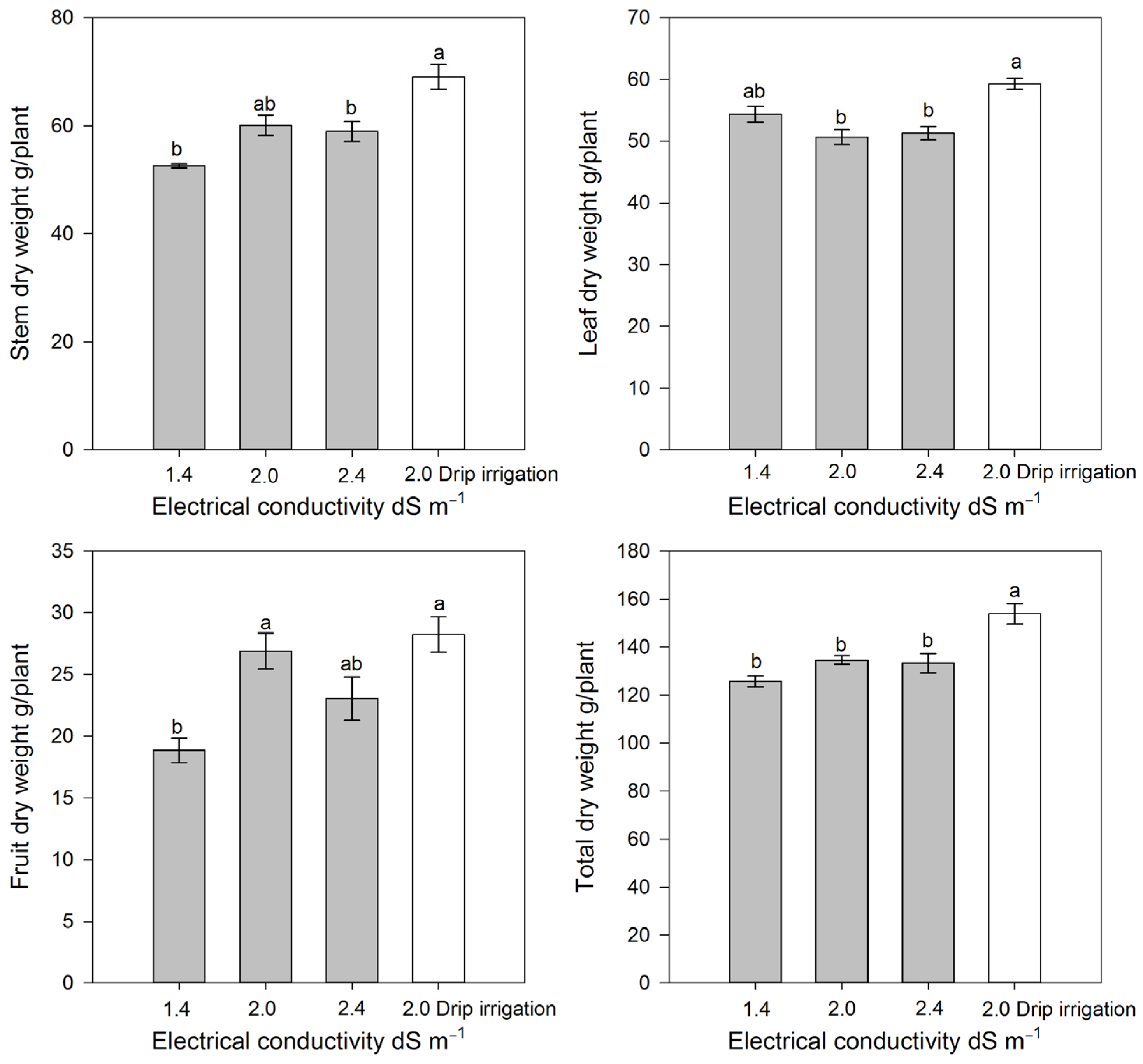
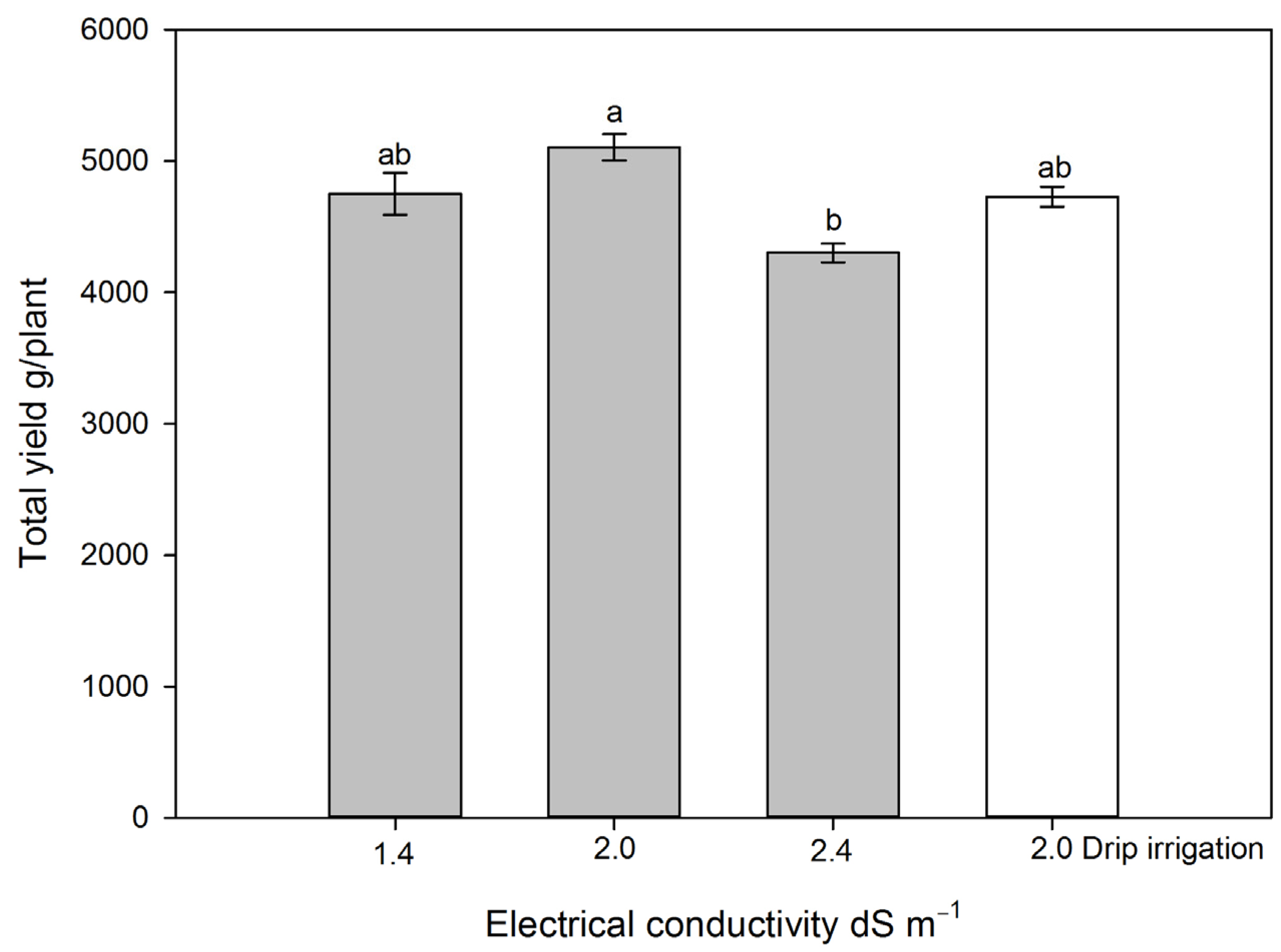
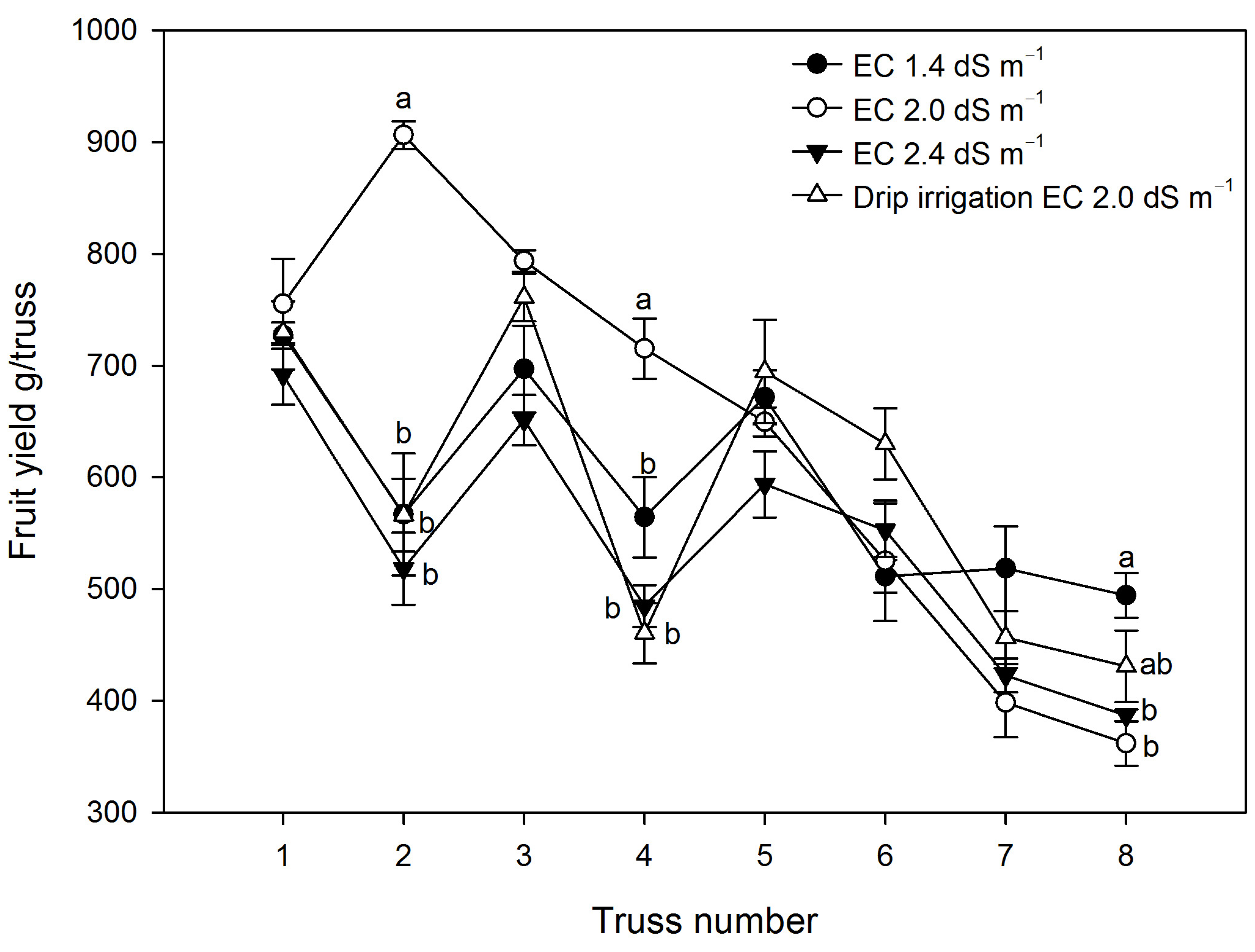
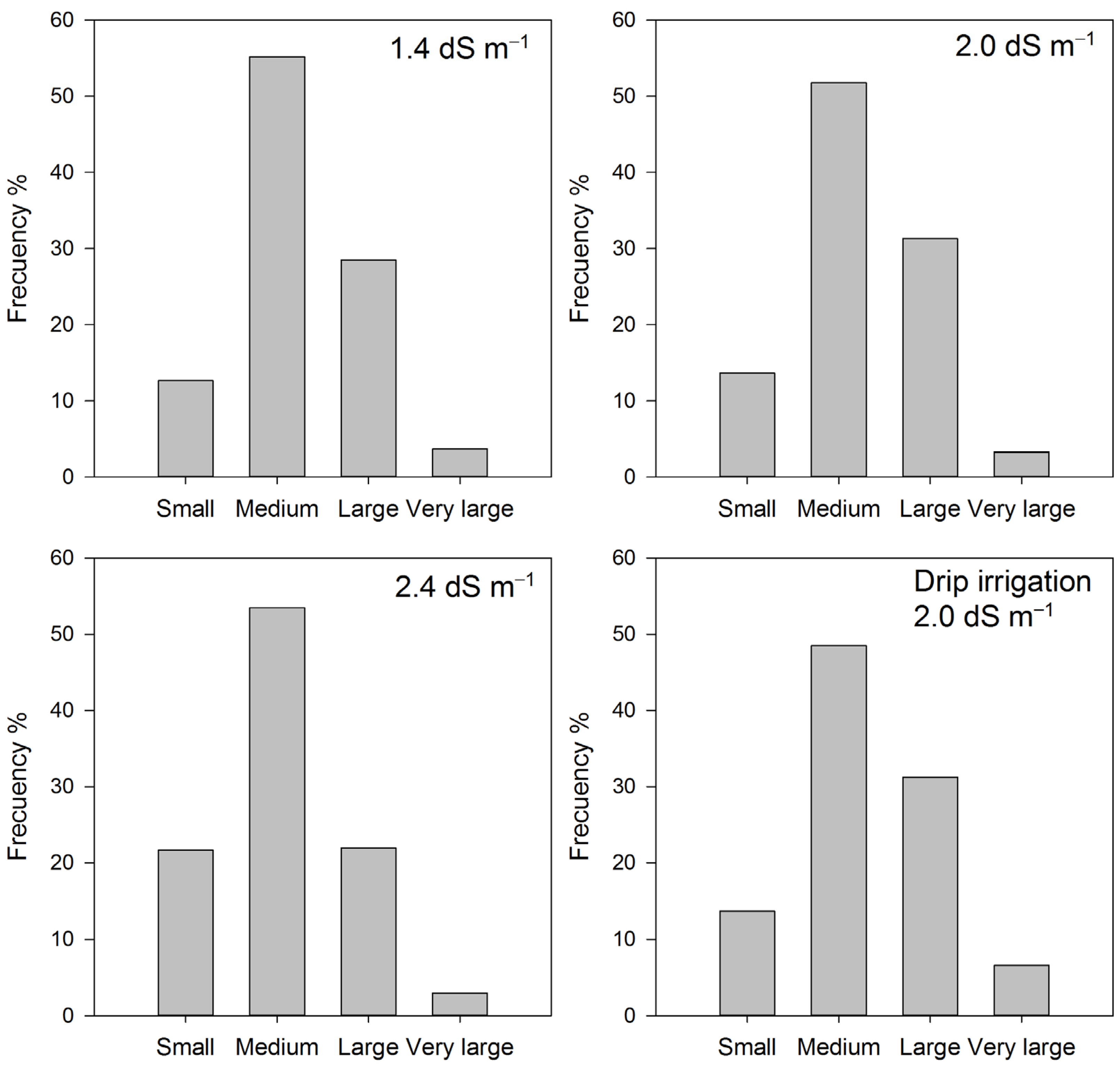


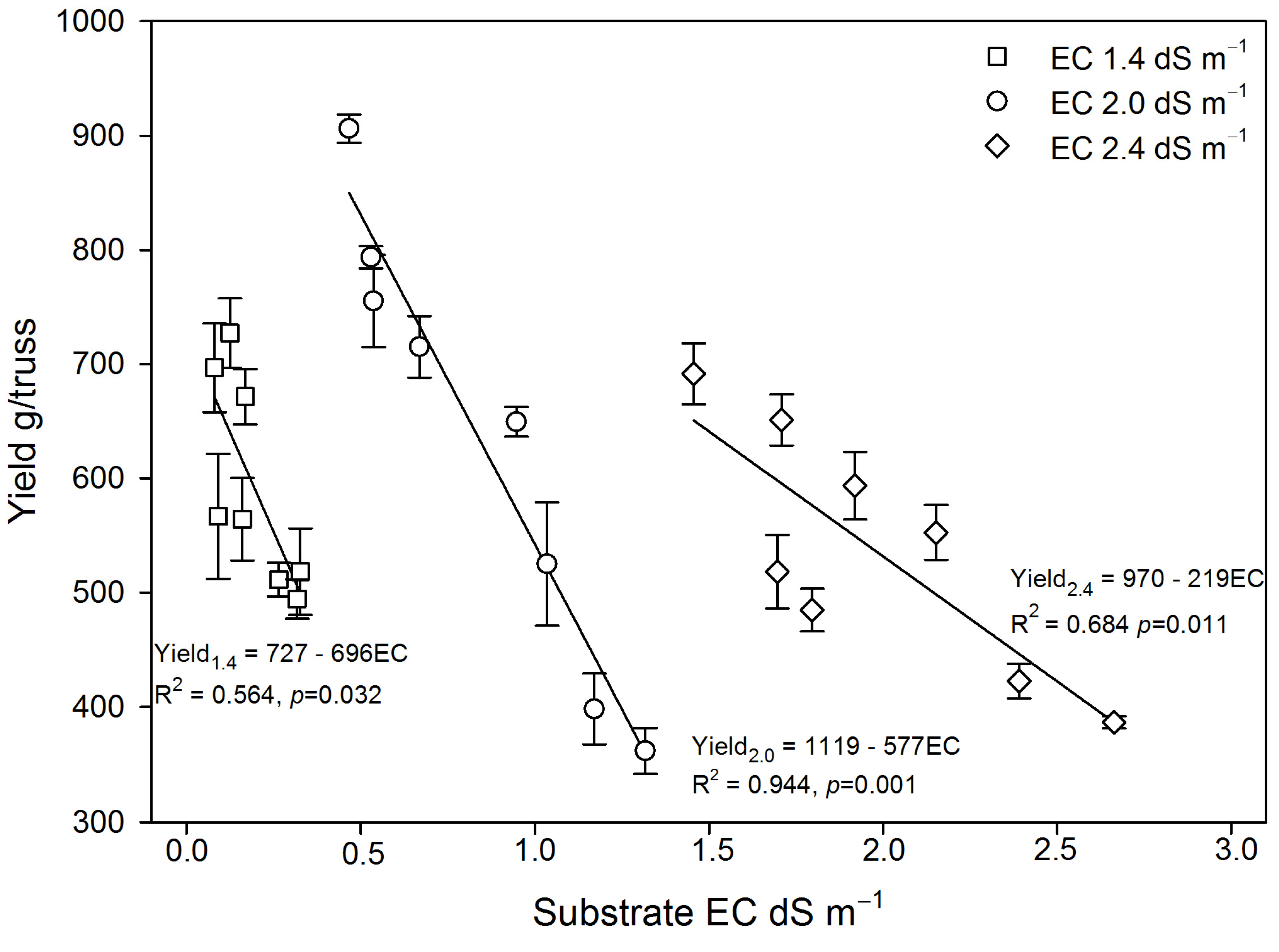
| Nutrient Solution EC dS m−1 | Substrate pH * | Substrate EC dS m−1 |
|---|---|---|
| 1.4 | 6.55 ± 0.08 a | 1.21 ± 0.09 c |
| 2.0 | 6.25 ± 0.04 b | 1.59 ± 0.15 b |
| 2.4 | 6.05 ± 0.03 c | 1.94 ± 0.17 a |
| 2.0 (Drip irrigation) | 6.27 ± 0.03 b | 0.88 ± 0.05 d |
Disclaimer/Publisher’s Note: The statements, opinions and data contained in all publications are solely those of the individual author(s) and contributor(s) and not of MDPI and/or the editor(s). MDPI and/or the editor(s) disclaim responsibility for any injury to people or property resulting from any ideas, methods, instructions or products referred to in the content. |
© 2023 by the authors. Licensee MDPI, Basel, Switzerland. This article is an open access article distributed under the terms and conditions of the Creative Commons Attribution (CC BY) license (https://creativecommons.org/licenses/by/4.0/).
Share and Cite
Méndez-Cifuentes, A.; Valdez-Aguilar, L.A.; Cadena-Zapata, M.; Alvarado-Camarillo, D.; González-Fuentes, J.A. Nutrient Solution Electrical Conductivity Affects Yield and Growth of Sub-Irrigated Tomatoes. Horticulturae 2023, 9, 826. https://doi.org/10.3390/horticulturae9070826
Méndez-Cifuentes A, Valdez-Aguilar LA, Cadena-Zapata M, Alvarado-Camarillo D, González-Fuentes JA. Nutrient Solution Electrical Conductivity Affects Yield and Growth of Sub-Irrigated Tomatoes. Horticulturae. 2023; 9(7):826. https://doi.org/10.3390/horticulturae9070826
Chicago/Turabian StyleMéndez-Cifuentes, Ariel, Luis Alonso Valdez-Aguilar, Martín Cadena-Zapata, Daniela Alvarado-Camarillo, and José Antonio González-Fuentes. 2023. "Nutrient Solution Electrical Conductivity Affects Yield and Growth of Sub-Irrigated Tomatoes" Horticulturae 9, no. 7: 826. https://doi.org/10.3390/horticulturae9070826
APA StyleMéndez-Cifuentes, A., Valdez-Aguilar, L. A., Cadena-Zapata, M., Alvarado-Camarillo, D., & González-Fuentes, J. A. (2023). Nutrient Solution Electrical Conductivity Affects Yield and Growth of Sub-Irrigated Tomatoes. Horticulturae, 9(7), 826. https://doi.org/10.3390/horticulturae9070826






